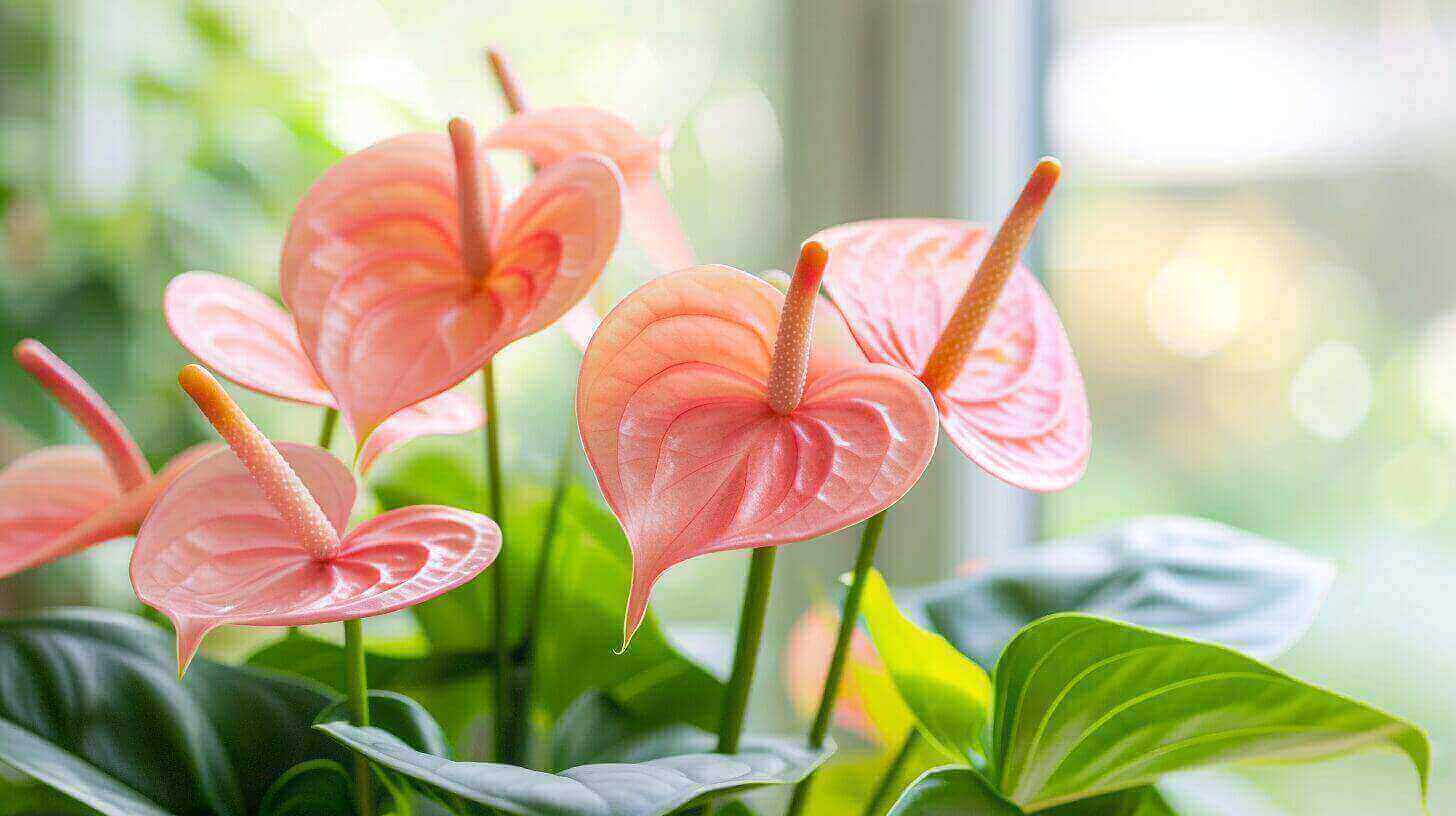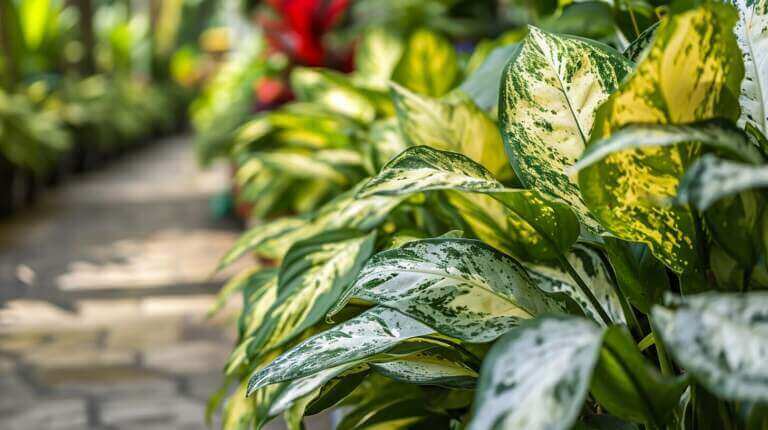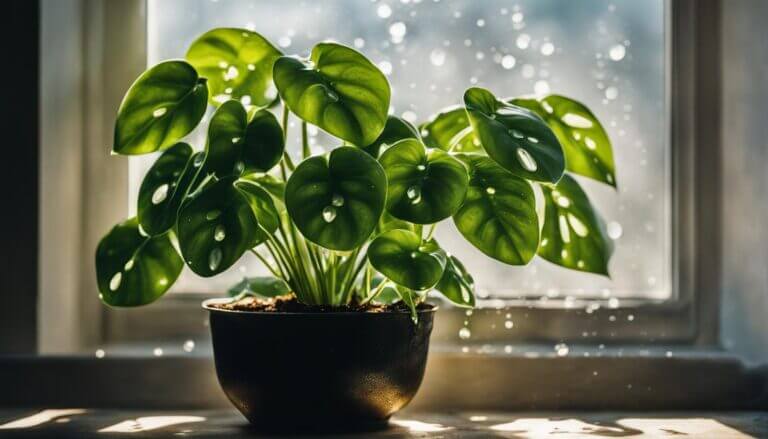Are you struggling to get your laceleaf anthuriums to bloom? Don’t worry, I’ve got you covered! In this article, I’ll share some valuable tips to help you achieve long-lasting and vibrant flowers. Laceleaf anthuriums, also known as Flamingo Flowers, are tropical plants that require specific care to thrive indoors. By providing the right conditions and following these tips, you’ll soon be enjoying a beautiful display of blooms in your home.
Key Takeaways:
- Place your laceleaf anthuriums near a sunny windowsill with indirect light to promote blooming.
- Mist the foliage or use a humidifier to maintain high humidity levels, which are crucial for these tropical plants.
- Water your plants once a week, allowing the soil to partially dry out between waterings to prevent root rot.
- Fertilize monthly with a phosphorous-rich fertilizer during the growing season to encourage blooming.
- Repot your anthuriums every two to five years and keep the leaves clean and dust-free for optimal health and blooming.
The Beauty of Laceleaf Anthuriums: A Unique Houseplant Option
Laceleaf Anthuriums, with their heart-shaped leaves and vibrant “flowers,” are a unique and beautiful addition to any indoor garden. These tropical plants, also known as Flamingo Flowers, come in a variety of colors, with red being the most common. Their delicate and intricate foliage is as stunning as their flowers, making them a long-lasting and visually appealing houseplant option.
Laceleaf Anthuriums are slow to moderate growers, but with the right conditions, they can thrive and add a touch of exotic beauty to any space. These plants are epiphytic, which means they can grow on other plants, so providing them with a well-draining and porous potting mix is essential for their success. The right potting mix helps to mimic their natural growing environment and ensures good airflow to the roots.
Laceleaf Anthuriums are a true showstopper with their striking foliage and unique flowers that add a touch of tropical elegance to any room. Their heart-shaped leaves come in various shades of green, sometimes with splashes of other colors or distinctive veining patterns. The vibrant spathes, often mistaken for flowers, are actually modified leaves that protect the tiny, inconspicuous flowers.
If you’re looking for a houseplant that stands out and adds a touch of sophistication to your space, laceleaf Anthuriums are an excellent choice. With their exotic appearance and unique growth habit, they are sure to impress both plant enthusiasts and visitors alike.
| Unique Features | Benefits |
|---|---|
| Heart-shaped leaves | Adds a touch of elegance |
| Vibrant spathes | Creates visual interest |
| Various colors available | Allows for personal preference |
| Long-lasting foliage | Provides year-round beauty |
Light and Placement: Essential for Anthurium Blooming
Proper lighting and placement are crucial factors for the blooming of Anthuriums. These tropical plants require bright, indirect light to thrive and produce beautiful flowers. Placing them near, but not directly on, a sunny windowsill can provide the ideal lighting conditions. Direct sunlight can cause burning of the leaves and flowers, while low light levels can lead to slow growth and no flowering. Mimicking their natural environment, Anthuriums prefer bright indirect light, replicating the cover of other plants under which they would grow in the wild.
When considering the placement of Anthuriums in your home, it’s essential to choose a spot that offers the right amount of light. This location should have enough light intensity to promote healthy growth and blooming, but not too much direct sunlight that could harm the plant. Placing the Anthurium near a shaded, east-facing window or using sheer curtains to filter the sunlight can provide the right balance of light for optimal blooming.
It’s important to note that the lighting requirements may differ slightly depending on the specific species or variety of Anthurium. Some varieties may tolerate lower light levels, while others may require brighter light to produce abundant flowers. Consulting the care instructions specific to your Anthurium variety can help ensure you provide the optimal lighting conditions for blooming success.
Table: Lighting Recommendations for Anthuriums
| Light Level | Description | Placement |
|---|---|---|
| Bright Indirect Light | Well-lit room without direct sunlight | Near a shaded, east-facing window |
| Moderate Light | Filtered or indirect light | 4-6 feet away from a south or west-facing window |
| Low Light | Dimly lit room with no direct sunlight | 6-8 feet away from a north or east-facing window |
Watering and Humidity: Key Factors for Anthurium Blooming
Proper watering and humidity levels are crucial for Anthurium blooming. These tropical plants require consistent moisture but are susceptible to root rot if overwatered. It’s essential to strike a balance by allowing the soil to partially dry out between waterings. This prevents waterlogged conditions that can harm the plant’s roots.
Anthuriums thrive in high humidity environments, as they are native to rainforest regions. Misting the foliage of your Anthurium plant a few times a week can help increase humidity levels. Alternatively, you can use a humidifier to create the ideal moisture-rich atmosphere around the plant. However, it’s important to avoid constantly wet conditions, as this can also lead to root rot.
“Proper watering and humidity levels are crucial for Anthurium blooming.”
The Importance of Proper Watering
Watering Anthurium plants correctly is key to their overall health and blooming potential. To provide adequate moisture, water your Anthurium once a week, allowing the top inch of soil to dry out before watering again. A good practice is to check the soil moisture level by inserting your finger into the soil. If it feels dry, it’s time to water.
Additionally, using a well-draining potting mix can further prevent waterlogging. This ensures that excess water can escape through the drainage holes, preventing water from pooling around the roots. Remember, consistency is key when it comes to watering Anthuriums, as both overwatering and underwatering can hinder blooming.
The Role of Humidity in Anthurium Blooming
Anthuriums thrive in humid environments, as they naturally grow in rainforest regions. The higher humidity levels help the plant absorb moisture through its leaves and maintain overall hydration. Misting the foliage regularly, especially during dry seasons or in centrally heated homes, can replicate these humid conditions and benefit the plant’s blooming.
In addition to misting, you can also place your Anthurium near a tray filled with water or use a humidifier to increase humidity levels. This becomes especially important if you live in a dry climate or if the air in your home tends to be dry. By providing sufficient humidity, you can create an environment that supports healthy growth and encourages your Anthurium to bloom.
| Watering Tips for Anthuriums | Humidity Tips for Anthuriums |
|---|---|
| Water once a week, allowing the top inch of soil to dry out. | Mist the foliage a few times a week to increase humidity levels. |
| Use a well-draining potting mix to prevent waterlogging. | Place the plant near a tray of water or use a humidifier. |
| Check the soil moisture level by inserting your finger into the soil. | Maintain consistent humidity levels to support healthy growth. |
Fertilizing and Repotting: Boosting Anthurium Blooming Potential
Fertilizing and repotting are important aspects of caring for Anthuriums and can significantly enhance their blooming potential. By providing the right nutrients and ensuring proper space for growth, you can encourage healthy foliage and vibrant flowers. Here are some essential tips for fertilizing and repotting your Anthurium plants:
Choosing the Right Fertilizer
When it comes to fertilizing Anthuriums, opt for a phosphorous-rich fertilizer. Phosphorous is a key nutrient that promotes root development and flower production. Look for a balanced fertilizer with a higher middle number on the packaging, such as 10-30-10 or 10-20-10. This indicates a higher concentration of phosphorous, which is crucial for blooming. Fertilize your Anthurium once a month during the growing season, following the package instructions for proper dosage.
Repotting for Growth
Repotting helps provide adequate space for your Anthurium to grow and allows fresh potting mix to replenish nutrients. Anthuriums generally require repotting every two to five years, depending on their growth rate. When repotting, choose a slightly larger pot with good drainage to prevent waterlogging. Gently remove the plant from its current pot, loosen the root ball, and place it in the new pot. Fill in the gaps with fresh, well-draining potting mix, and water the plant thoroughly after repotting.
Taking Care of Root Bound Plants
If you notice that your Anthurium has become root bound, with roots circling the edges of the pot, it is important to address this issue. Gently tease out the root ball and trim away any excessive or congested roots. Repot the plant in a slightly larger pot with fresh potting mix, following the same steps mentioned above. Root bound plants can struggle to absorb nutrients and water, hindering blooming, so addressing this issue is crucial for optimal growth.
| Benefits of Fertilizing and Repotting | Frequency |
|---|---|
| Promotes root development | Once a month during the growing season |
| Increases flower production | Every two to five years for repotting |
| Provides fresh nutrients | When necessary, if the plant becomes root bound |
Fertilizing and repotting are essential practices for boosting Anthurium blooming potential. By providing the right nutrients and ensuring ample space for growth, you can enhance the overall health of your plant and enjoy beautiful, long-lasting flowers. Remember to follow the proper guidelines for fertilizing and repotting, and your Anthuriums will thrive in their blooming journey.
Cleaning and Maintenance: Ensuring Anthurium Blooming Success
Proper cleaning and maintenance are crucial for the success of Anthurium blooming. Regular cleaning of the leaves not only enhances the plant’s appearance but also promotes photosynthesis. A soft, damp cloth can be used to gently wipe away dust and debris, allowing the leaves to absorb essential light and nutrients effectively. By maintaining clean foliage, you can ensure that your Anthurium stays healthy and blooms to its full potential.
Another important aspect of maintenance is the removal of dead or brown flowers. By pruning these spent blooms, you can encourage the plant to redirect its energy towards producing new buds and flowers, resulting in a more vibrant display. Additionally, any yellow or brown leaves should be promptly removed to maintain the overall aesthetics of the plant.
Keeping an eye out for pests is also an integral part of Anthurium care. Common pests that can affect Anthuriums include mealybugs, scale, and aphids. Regularly inspect the foliage for signs of infestation, such as sticky residue, discolored leaves, or visible pests. If any pests are detected, appropriate measures should be taken to eliminate them, such as using organic insecticidal soap or neem oil.
In summary, proper cleaning and maintenance practices contribute to the successful blooming of Anthuriums. By cleaning the leaves, removing dead flowers, and monitoring for pests, you can ensure that your Anthurium plant remains healthy, visually appealing, and ready to bloom.
Anthurium Varieties and Fun Facts: Exploring the World of Laceleaf Anthuriums
When it comes to anthuriums, there is a world of variety to explore. Laceleaf anthuriums, with their heart-shaped leaves and vibrant spathes, are particularly popular among plant enthusiasts. These stunning plants are part of the Araceae family and are native to warm, tropical regions.
With their unique growth habits, laceleaf anthuriums can be found as both epiphytic and ground-dwelling species. They thrive in warm temperatures, high humidity, and well-draining soil. Their beautiful spathes, often mistaken for flowers, come in a variety of colors, with red being the most common.
While exploring the world of laceleaf anthuriums, it’s important to note that these plants are considered toxic and may cause skin irritation, so handling them with caution is advised. However, their captivating beauty and diverse varieties make them an exciting addition to any indoor garden.
FAQ
How often should I water my laceleaf Anthurium?
Water your laceleaf Anthurium once a week, allowing the soil to partially dry out between waterings. This helps prevent root rot.
How should I provide humidity for my laceleaf Anthurium?
You can increase humidity levels for your laceleaf Anthurium by misting the foliage a few times a week or using a humidifier.
How often should I fertilize my laceleaf Anthurium?
Fertilize your laceleaf Anthurium once a month during the growing season with a phosphorous-rich fertilizer to promote blooming.
How frequently should I repot my laceleaf Anthurium?
Repot your laceleaf Anthurium every two to five years, using a well-draining potting mix and a slightly larger pot to accommodate its growth.
How can I keep my laceleaf Anthurium clean and free from pests?
Clean the leaves regularly with a soft, damp cloth to remove dust. Prune yellow or brown leaves and remove dead flowers. Monitor for pests like mealybugs, scale, and aphids.
Are Anthuriums toxic?
Yes, Anthuriums are considered toxic and may cause skin irritation. Take caution when handling them.







